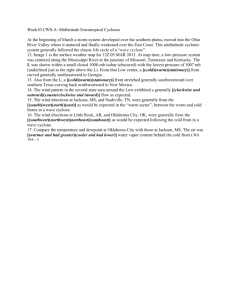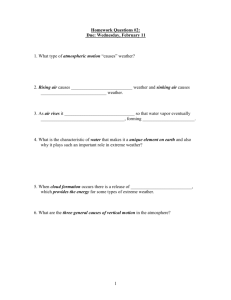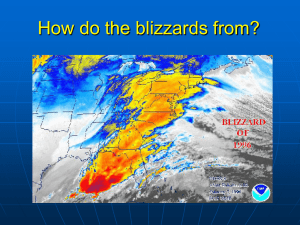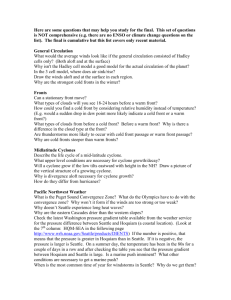ESCI 107 – The Atmosphere Lesson 13 – Fronts and Midlatitude
advertisement
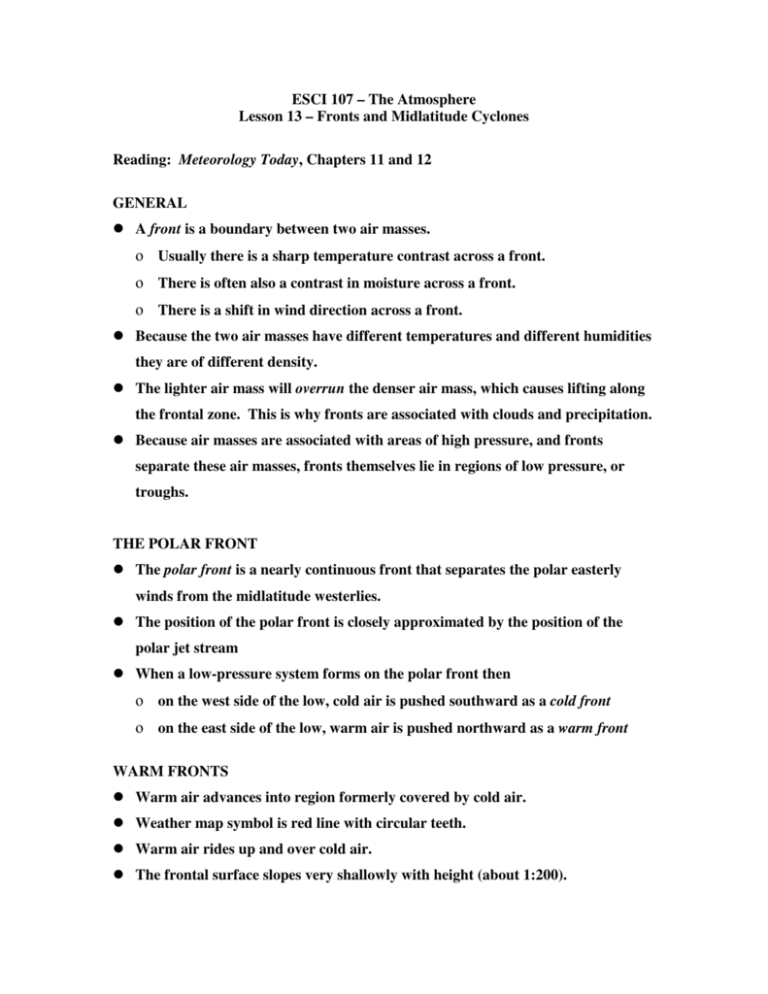
ESCI 107 – The Atmosphere Lesson 13 – Fronts and Midlatitude Cyclones Reading: Meteorology Today, Chapters 11 and 12 GENERAL A front is a boundary between two air masses. ο Usually there is a sharp temperature contrast across a front. ο There is often also a contrast in moisture across a front. ο There is a shift in wind direction across a front. Because the two air masses have different temperatures and different humidities they are of different density. The lighter air mass will overrun the denser air mass, which causes lifting along the frontal zone. This is why fronts are associated with clouds and precipitation. Because air masses are associated with areas of high pressure, and fronts separate these air masses, fronts themselves lie in regions of low pressure, or troughs. THE POLAR FRONT The polar front is a nearly continuous front that separates the polar easterly winds from the midlatitude westerlies. The position of the polar front is closely approximated by the position of the polar jet stream When a low-pressure system forms on the polar front then ο on the west side of the low, cold air is pushed southward as a cold front ο on the east side of the low, warm air is pushed northward as a warm front WARM FRONTS Warm air advances into region formerly covered by cold air. Weather map symbol is red line with circular teeth. Warm air rides up and over cold air. The frontal surface slopes very shallowly with height (about 1:200). The front moves forward at 15 - 20 mph. Cloud sequence associated with advance of warm front ο cirrus ο cirrostratus (possibly cirrocumulus) ο altostratus ο nimbostratus (sometimes with embedded cumulonimbus) The precipitation associated with warm fronts is steady rain or drizzle. If air is cold enough, then steady snow. When freezing rain or sleet occur, it is most often because of a warm front. COLD FRONT Cold air advances into region formerly covered by warm air. Weather map symbol is blue line with triangular teeth. Warm air rides up and over cold air. The frontal surface has a steeper slope than a warm front (about 1:100) The front moves forward at 20 - 35 mph (much faster than warm front). Cloud sequence associated with advance of cold front ο cirrus and cirrostratus (from thunderstorm anvils) ο altocumulus (sometimes) ο cumulonimbus The precipitation associated with cold fronts is rain or snow showers, and sometimes thunderstorms (especially in the summer). Precipitation region is much narrower with a cold front than with a warm front. Precipitation region can be either ahead of or behind cold front. Cold front is often associated with squall line ahead of front. STATIONARY FRONT Boundary between air masses is not moving Weather map symbol is alternating red and blue line with alternating warm and cold front teeth pointing in opposite directions. 2 Even though frontal boundary itself doesn’t move, the warm air is still moving up and over the cold air. Clouds associated with stationary fronts are usually stratiform (stratus, nimbostratus, altostratus, cirrostratus). Precipitation is usually light to moderate, and steady (rain or snow). Stationary fronts can linger for days, causing prolonged periods of dreary weather. OCCLUDED FRONTS Occur when a cold front overtakes a warm front Weather map symbol is a purple line with both sharp and circular teeth pointing in the same direction. There are two types of occlusions ο cold occlusion – air behind cold front is colder than air ahead of warm front ο warm occlusion – air behind cold front is warmer than air ahead of warm front Clouds associated with occluded fronts are a complicated mixture of those associated with warm and cold fronts. DRY LINES Not all fronts are associated with a temperature contrast. Some are only associated with a humidity contrast (remember that moist air is lighter than dry air). A dry-line front often forms in the West Texas, Oklahoma Panhandle, and Western Kansas region, and is a boundary between cT and mT air masses. This dry-line front spawns thunderstorms and tornadoes in this region. MORE ABOUT FRONTS The faster a front moves, the more severe the weather will be (which is why cold fronts are more violent than warm fronts). 3 The sharper the temperature contrast across the front, the more severe the weather will be. Sometimes, fronts are dry, meaning that even though there is uplifting along the front, there is not enough moisture to cause clouds or precipitation. In the eastern U.S. ο most cold fronts are between cP and mT air masses. ο most warm fronts are between cP and mT air masses, or sometimes between mP and mT air masses (such as in a nor’easter). In the summer, sometimes the temperature contrast across the front is not very great. This is what the T.V. meteorologists sometimes call a cool front, but technically it is still a cold front. MIDLATITUDE CYCLONES A cyclone technically refers to any cyclonically rotating circulation. Cyclonic rotation is associated with low-pressure systems, so that cyclone and low can be used interchangeably. In this chapter we will use the term cyclone to refer specifically to midlatitude or extratropical cyclones that form along the polar front. The term cyclogenesis refers to cyclone formation. POLAR-FRONT THEORY OF CYCLONE FORMATION Norwegian meteorologists studies cyclone formation and development during World War I, using mainly surface observations. They formulated what became known as the polar-front theory of cyclone formation. Stages of cyclone development ο Front develops (known as frontogenesis). ο A wave develops on the front: frontal wave stage. ο A cyclonic circulation (low-pressure) becomes established: open-wave stage ο The cold front overtakes the warm front, beginning the occlusion: mature stage. 4 ο The occluded front continues to develop as the cyclone reaches maturity: advanced occlusion stage ο The cyclone becomes cut-off and begins to dissipates because it has mixed away the temperature contrast across the front: cut-off stage The energy that drives the cyclone is derived from the temperature contrast across the front. It is converting potential energy to kinetic energy. After the cyclone has mixed away the temperature contrast across the front there is no longer any potential energy available to keep the cyclone going, so it dissipates. NOTE THAT THE CYCLONE IS SERVING TO REDUCE THE LATITUDINAL HEAT IMBALANCE BY TRANSPORTING WARM AIR TOWARD THE POLE AND COLD AIR TOWARD THE EQUATOR! The lifetime of the cyclone is roughly 3 – 5 days from the initial wave to the dissipating stage. CLOUDS AND WEATHER ASSOCIATED WITH MIDLATITUDE CYCLONES The cloud pattern associated with the mature cyclone has a comma or wishbone shape. The weather associated with the passage of a midlatitude cyclone depends on where you are relative the center of the low. ο If you are well to the south you will experience the weather associated with a warm front, followed by that of a cold front. ο If you are to the north you will either experience the occluded front, or no front. The weather will be characterized by lots of clouds, precipitation, and wind. This poor weather can last for a day or more, since the low is traveling slower than the fronts themselves. ο During the winter it is the northern area of the cyclone that tends to get the most snow. MOVEMENT OF MIDLATITUDE CYCLONES 5 Most of the so-called bad weather experienced in the U.S. is associated with warm and cold fronts associated with midlatitude cyclones. Therefore, a key to weather forecasting is not only to predict when a cyclone will develop, but where it will move once it has developed. Once a cyclone forms on the polar front it tends to move eastward along the front (much like a wave on a tight string). ο One reason that the cyclone travels along the front is that it is the temperature contrast across the front that feeds energy to the cyclone. ο Another reason that cyclones tend to move along the polar front is that the upper-level winds (including the jet stream) usually flow somewhat parallel to the polar front (remember that the position of the jet stream is linked very closely with the position of the polar front). ο The upper-level winds are sometimes thought of as steering currents that push the cyclone along. Although this is an oversimplification, it is useful when trying to visualize cyclone movement. 6


